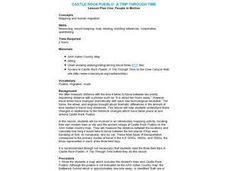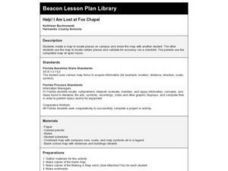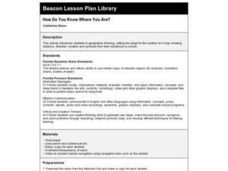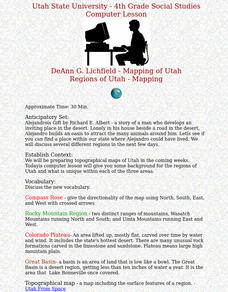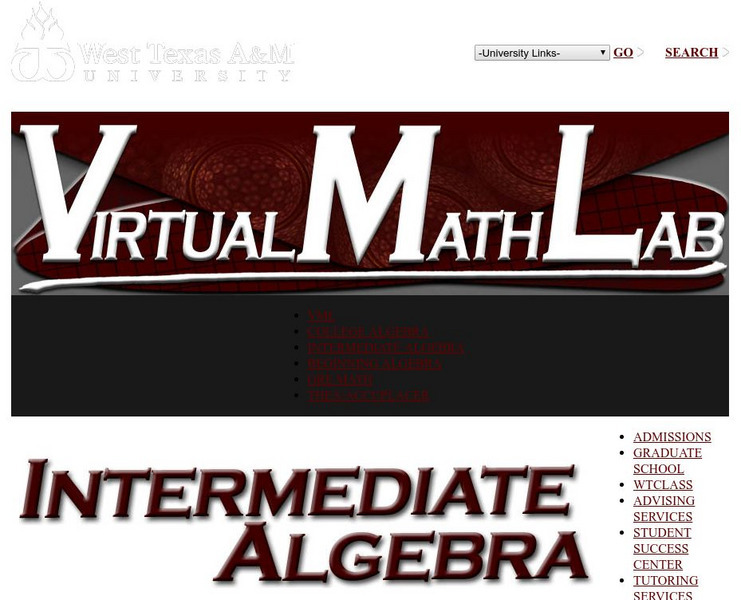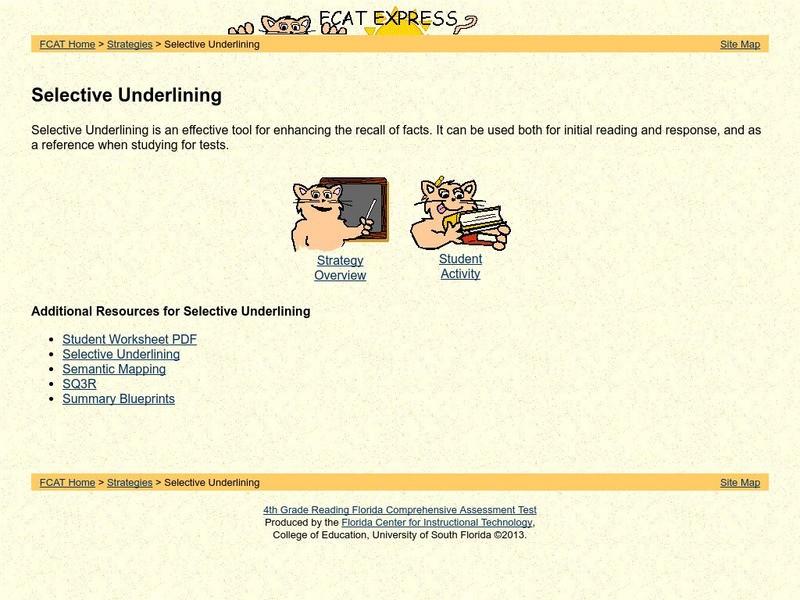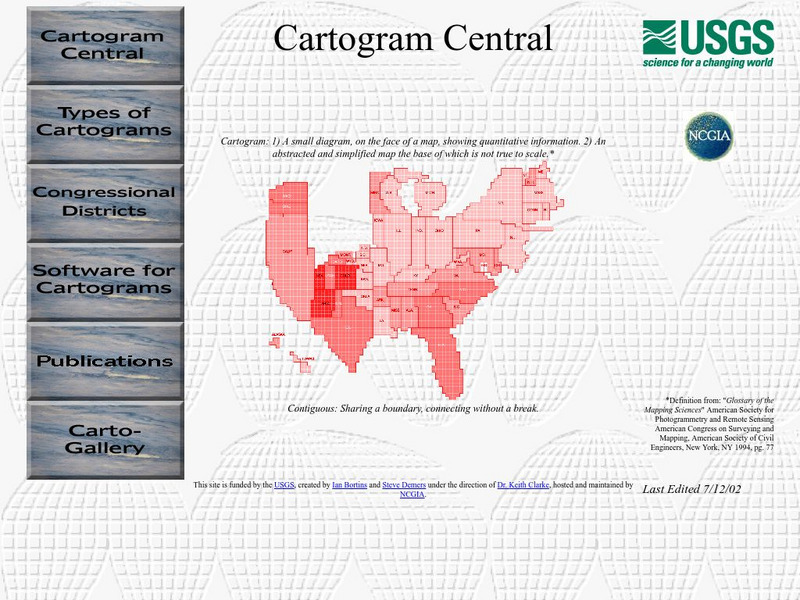Curated OER
Mapping It Out: A Post-Trip Lesson
Students make a rough map of Yosemite and add elevations to the map. They are encouraged to bring photos from the trip and add them to their map.
Curated OER
CASTLE ROCK PUEBLO: A TRIP THROUGH TIME
Students use a map to respond to a series of questions. They determine how much time it would take to travel to Castle Rock Pueblo from different pueblos and locate modern pueblos on the Indian Country map.
Curated OER
Help! I Am Lost at Fox Chapel
Sixth graders create a map to locate places on campus and share the map with another student. The other students use the map to locate certain places and validate for accuracy via a checklist. The parents use the completed map at open...
Curated OER
From Pirates to Pilots to Spies
Sixth graders enjoy this introduction to the world of map projections, globes, aerial photographs, and satellite images. This lesson instructs students on the advantages and disadvantages of each earthly representation.
Curated OER
How Do You Know Where You Are?
Seventh graders are introduced to geographic thinking, setting the stage for the creation of a map showing distance, direction, location and symbols from their residences to school.
Curated OER
Nevada Trilogy
Students simulate and plan a trip from St. Louis to the Sacramento Valley as early emigrant parties would have. They list necessary provisions for the amount of time they would spend traveling.
Curated OER
Elements Of Mapping
Students create mental maps, compare their maps to street maps, and label the five elements of mapping. They create a mental map of their neighborhood, which include a legend and an icon for each of the five maps.
Curated OER
Any Town, USA
Students launch an investigation of their home town by creating a mental map and examining the livability factors from their perspective. After completing their map, students write a brief description of their town
Curated OER
Minnesota Floor Map
Students examine the physical geography of Minnesota, work cooperatively to design a map of Minnesota and develop spatial and relative location of Minnesota landmarks and physical characteristics.
Curated OER
Geo-Town
Second graders use a checklist to construct a Geo-Town map including a compass rose, a map key, and a paragraph about a walk around Geo-Town, using appropriate geometric and directional vocabulary to identify the two-dimensional figures...
Curated OER
Regions of Utah - Mapping
Fourth graders draw a rudimentary map of the state of Utah, dividing it into the three regions: the Great Basin, the Colorado Plateau, and the Rocky Mountain Region.
Curated OER
Basic Ideas of Geography
Students understand that geography helps one to see links with people and places across the country and around the world. Four key ideas of geography are studied.
Science Buddies
Science Buddies: Career Profile:cartographers and Photogrammetrists
Cartographers and photogrammetrists--big words for careers in mapping, both 2-D and 3-D. Watch interviews with people who use their expertise in geographic information to help make policy decisions. This Science Buddies site lays out the...
SUNY Empire State College
Empire State College: Developing Ideas for Writing
Explains nine methods for developing ideas for writing, including freewriting, brainstorming, clustering/mapping, maintaining a personal journal, responding to a text, maintaining a response journal, responding to a specific assignment,...
Texas A&M University
Wtamu Virtual Math Lab: Intermediate Algebra
This site is a tutorial for students in algebra 2 or for those who need a refresher. The site has explanations, definitions, examples, practice problems and practice tests are found covering topics such as linear equations, graphing,...
Discovering Lewis & Clark
Discovering Lewis & Clark: Geography
How did Lewis and Clark map the unknown lands? Learn how they marked the territory using mental mapping, Indian spatial concepts, and formal navigation.
University of South Florida
Fcat Express: Probable Passage
Site provides extensive assistance in preparing 4th grade students for Florida Comprehensive Assessment Test. This section provides help in using the "probable passage" technique to aid comprehension. In addition, links are available to...
University of South Florida
Fcat Express: Semantic Feature Analysis
Site provides extensive assistance in preparing 4th grade students for Florida Comprehensive Assessment Test. This section on semantic features helps students recognize supporting details as they read.
University of South Florida
Fcat Express: Selective Underlining
Site provides extensive assistance in preparing 4th grade students for Florida Comprehensive Assessment Test. This section focuses on identifying main ideas and significant details by selectively underlining them in a text.
Other
Bucks County Community College: Visual Organizers
This site walks you through the benefits of visual organizers, and focuses on a variety of types: tables, charts, graphs, timelines, flowcharts, diagrams, and webs.
US Geological Survey
U.s. Geological Survey: 27 Ideas for Teaching With Topographic Maps
A collection of twenty-seven activities that can be done with topographic maps, for elementary up to university level students. Includes many accompanying resources.
University of California
Us Geological Survey: Cartogram Central
The USGS offers detailed information on Types of Cartograms, Congressional Districts, Software for Cartograms, Publications, and a Carto-Gallery.
NOAA
Noaa: National Ocean Service Education: Global Positioning Tutorial
Illustrated tutorial explains the history and science of geodesy. Animations help students visualize how scientists measure and monitor the size and shape of the Earth and the location of points on its surface.
ReadWriteThink
Read Write Think: Scaffolding Summarization With Fishbone Mapping
Lesson that teaches students how to find important and significant information while reading text. After locating information through strategies, students learn how to summarize content-area text. A downloadable fishbone template is linked.

